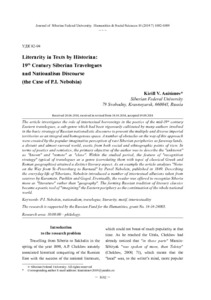Literarity in Texts by Historian: 19th Century Siberian Travelogues and Nationalism Discourse (the Case of P.I. Nebolsin)
Скачать файл:
URI (для ссылок/цитирований):
https://elib.sfu-kras.ru/handle/2311/13387Автор:
Anisimov, Kirill V.
Анисимов, К.В.
Дата:
2014-10Аннотация:
The article investigates the role of intertextual borrowings in the poetics of the mid-19th century
Eastern travelogues, a sub-genre which had been vigorously cultivated by many authors involved
in the basic strategy of Russian nationalistic discourse to present the multiple and diverse imperial
territories as an integral and homogenous space. A number of obstacles on the way of this approach
were created by the popular imaginative perception of vast Siberian peripheries as faraway lands,
a distant and almost surreal world, exotic from both social and ethnographic points of view. In
terms of poetics and semiotics, the primary objective of the author was to describe the "unknown"
as "known" and "remote" as "close". Within the studied period, the feature of "recognition
strategy" typical of travelogues as a genre (correlating them with topoi of classical Greek and
Roman geographies) attained a distinct literary aspect. As an example the article analyzes "Notes
on the Way from St.-Petersburg to Barnaul" by Pavel Nebolsin, published in 1849. Describing
the everyday life of Siberians, Nebolsin introduced a number of intertextual allusions taken from
oeuvres by Karamzin, Pushkin and Gogol. Eventually, the reader was offered to recognize Siberia
more as "literature" rather than "geography". The forming Russian tradition of literary classics
became a poetic tool of "imagining" the Eastern periphery as the continuation of the whole national
world. В статье исследуется роль интертекстуальных заимствований в поэтике восточного
травелога середины XIX в., субжанра, развивавшегося в русле интеграционных стратегий
русского национализма, одной из ключевых задач которого было создание образа гомогенного
пространства, приходящего на смену картинам пестрого имперского мира. Существенную
сложность на пути развития этого подхода представляли огромные сибирские окраины,
типичные имперские владения, располагавшие немалой этнографической оригинальностью. В
терминах поэтики и семиотики задача, стоящая перед автором, заключалась в том, чтобы
описать "незнакомое" как "знакомое" и "далекое" как "близкое". Издавна присущая травелогу
как жанру стратегия "узнавания" (та или иная новая локальность соотносилась европейским
автором с топосами классических землеописаний) обретает в исследуемый период отчетливо
художественный аспект. В качестве примера в статье рассматриваются опубликованные
в 1849 г. историком П.И. Небольсиным "Заметки на пути из Петербурга в Барнаул". В своих
зарисовках сибирского быта автор прибегает к коллажу интертекстуальных цитат из
наследия Карамзина, Пушкина и Гоголя. В результате читателю предлагается "узнать"
Сибирь не столько как "географию", сколько как "литературу". Формирующаяся литературная
классика становится поэтическим инструментом "воображения" восточной окраины как
продолжения целостного национального мира

